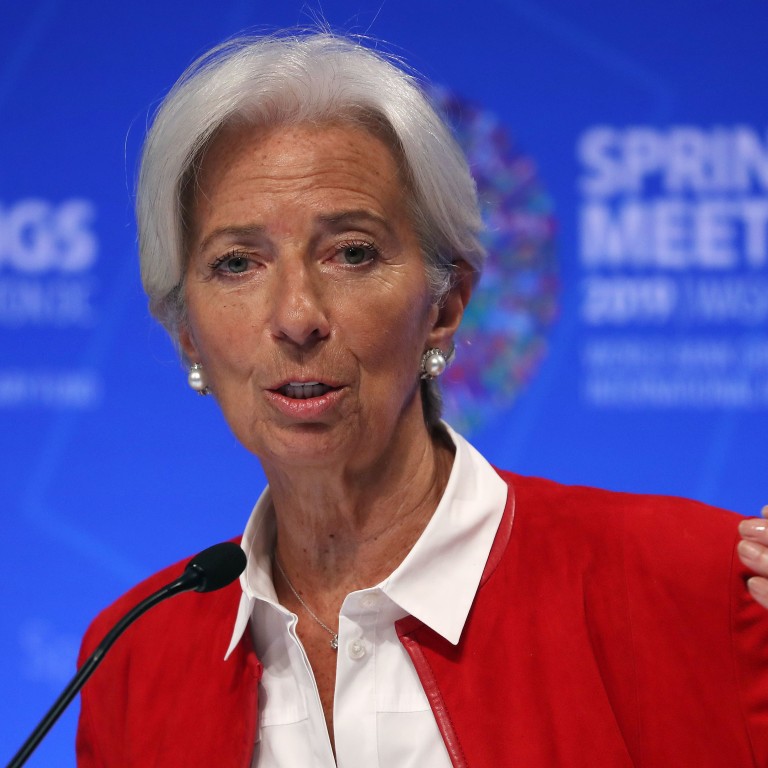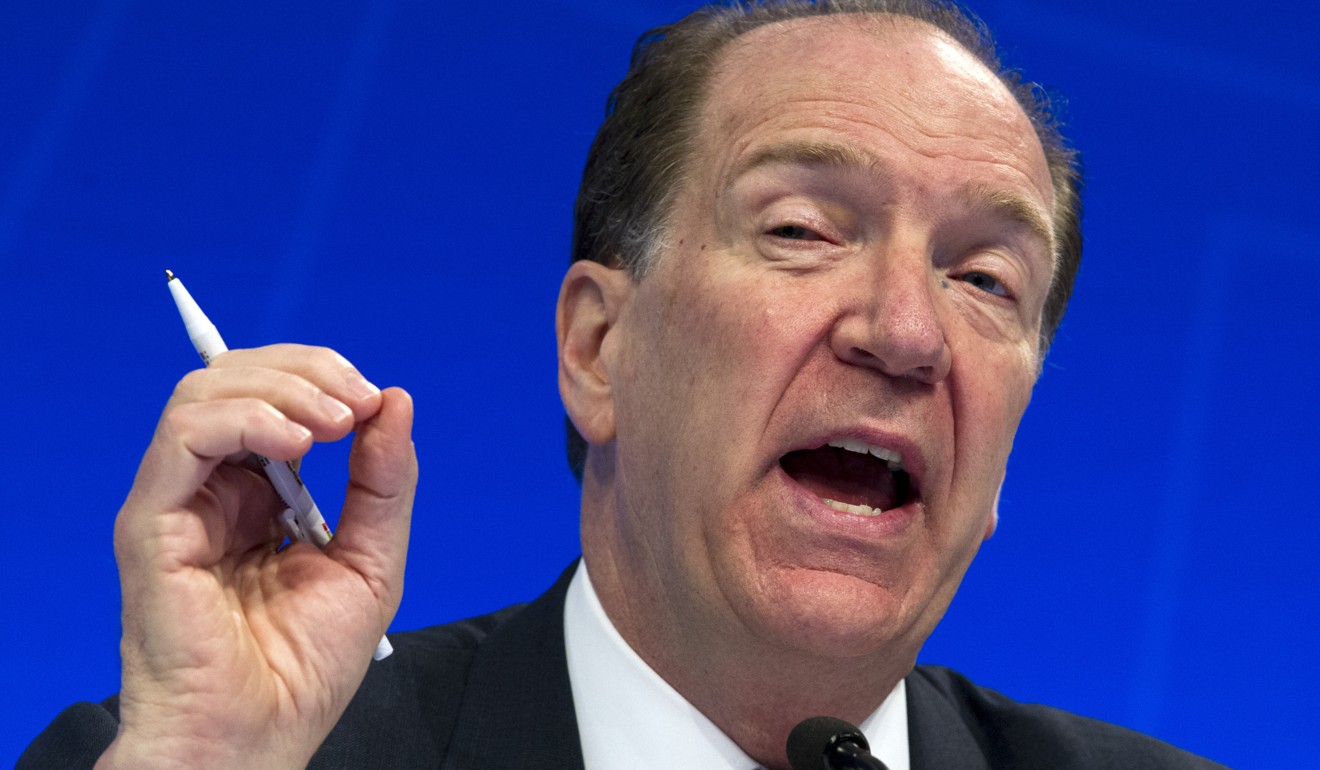
IMF leader Christine Lagarde praises China’s economic stimulus but warns on debt-heavy belt and road loans
- High on Lagarde’s list of self-inflicted economic wounds is the US-China trade war and its hundred of billions of dollars in tariffs
- Concern that some Asian, African and Latin American borrowers may not be able to repay Beijing, leaving them politically and economically vulnerable
Lower global debt levels, more disciplined tax policy and an end to trade battles that result in “self-inflicted wounds” are needed to shore up the global economy at a delicate juncture, the head of the International Monetary Fund warned on Thursday, while adding that China’s recent stimulus moves are welcome as long as excessive debt-fuelled investment is avoided.
Christine Lagarde, the IMF’s managing director, said global leaders should address looming problems before the next downturn, and drew a parallel with global warming.
“Just like nature, the global economy is also currently quite uncertain,” she said in Washington at the spring meetings of the IMF and World Bank. “We certainly would recommend two key principles. One is do no harm. Second is do the right thing.”
Those recommended measures include addressing distortions in the global trading system, reforming the Geneva-based World Trade Organisation, resolving uncertainty over Brexit and having nations adopt stronger financial policies. High on the list of “self-inflicted wounds” is the China-US trade war, which has seen hundreds of billions of dollars’ worth of tariffs slapped on manufactured goods, unsettling global markets and adding to the uncertainty.
On Tuesday, the IMF slashed its 2019 global growth forecast to 3.3 per cent from 3.6 per cent in 2018 even as it boosted its outlook for China’s annual growth to 6.3 per cent, up 0.1 percentage point from its last forecast. Beijing’s recent stimulus moves and a better outlook for a US-China trade deal spurred the change.
As China’s global footprint has expanded, its lending activities as part of its “Belt and Road Initiative” have come under a spotlight amid concern that some Asian, African and Latin American borrowers may be unable to repay Beijing, leaving them politically and economically vulnerable.
An example is crisis-hit Venezuela, which owes China an estimated US$20 billion as it struggles with a leadership and humanitarian crisis and little immediate ability to repay the debt. Africa has received particular scrutiny given expansive Chinese lending as part of the Asian giant’s search for resources to fuel its growing economy.
Beijing doesn’t release data on its overseas loans, but the Johns Hopkins School of International Advanced Studies estimates that China lent US$143 billion to African countries between 2000 and 2017. Much of that remains unpaid.
Lagarde said the IMF and World Bank were trying to bring more transparency to Chinese lending practices in Africa to better identify debt levels, loan terms and maturity dates. “It’s clear that any debt restructuring programmes going forward in the years to come will be more complicated than debt restructuring programmes that we conducted 10 years ago,” she said.
Newly named World Bank President David Malpass said on Thursday that he had met with Jin Liqun, president of the Beijing-based Asia Infrastructure Investment Bank (AIIB), during the week-long gathering in Washington.
The two institutions have weathered sometimes testy relations as the AIIB has called for more efficient, less bureaucratic multilateral lending – an implicit criticism of the US-led World Bank, the Asian Development Bank and other established players.

But Malpass said Thursday that there was room for varied multilateral institutions, given the huge global need for development aid. “We had very good conversations about ways that we can, that there can be cooperation that achieves very high-quality lending programmes,” he said.
While China received a nod of approval from the IMF for its recent measured stimulus to shore up its economy, the world’s second largest, economists cite deep structural problems.
State-owned enterprises are often highly inefficient and deep under water, with China among the world’s most indebted countries as household, government and corporate debt approach 300 per cent of gross domestic product, according to the Institute of International Finance.
“China is ageing rapidly and is set to face its most abrupt decline in population in centuries, setting the stage for potential macroeconomic and social vulnerabilities going forward,” the group said in a white paper released on Thursday. “Beijing has its hands full and the world is watching.”
Louis Kuijs, Hong Kong-based head of Asian economics with Oxford Economics and a former IMF official, said he expected China’s rate of economic growth to stop falling in the second quarter of this year.
“However, still anxious to avoid another credit binge, Beijing’s ambitions on growth are more modest now than in the past,” Kuijs said. “Thus, people that expect a major growth recovery in China this year are going to be disappointed.”

Oxford Economics said it expected global growth to pick up in the second half of the year after a nine-month slowdown, aided by a more stable Chinese economy and an upturn in Europe and some major developing economies.
Lagarde’s call for countries to clean up their acts before the next downturn is valid, economists said. But in the real world, politicians too often focus on the next election or, in countries such as China, concern that job losses could fuel social instability.
This all comes as central banks around the world bow to political pressure to increase monetary supply. In the US, President Donald Trump has launched unprecedented verbal attacks on the Federal Reserve, which, related or not, have dovetailed with an easing bias that other central banks seem inclined to follow.
“The Fed U-turn quickly led to changes in the outlook for Asian interest rates as well,” Kuijs said.
An Oxford Economics report due for release soon identifies a clear “structural shift” towards more government spending and higher fiscal deficits in more advanced Asian societies such as Singapore, Hong Kong and South Korea as well as others facing elections, notably India and Indonesia, making them less resilient when the next downturn hits.
“While Lagarde’s advice is sensible,” Kuijs said, “it remains to be seen how many countries will listen.”

